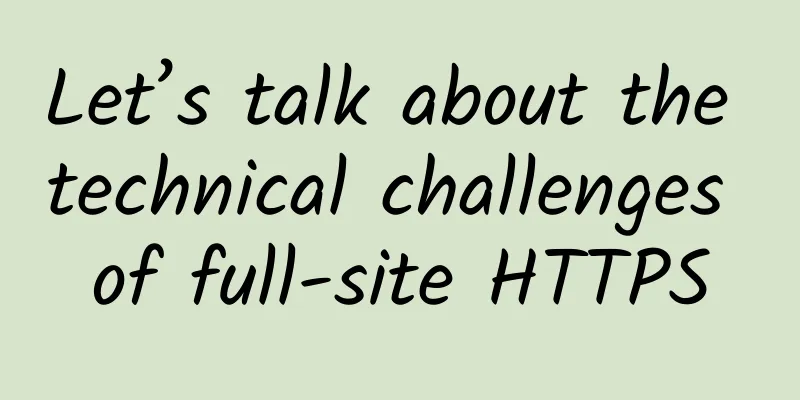Let’s talk about the technical challenges of full-site HTTPS

|
The article I wrote recently discussed the issue of data transmission security, and the last part mentioned the solution to data transmission security through HTTPS. Then a new question arises: what technical problems may we encounter in the process of implementing HTTPS throughout the site? So today, let's do the math together and sort out the technical costs.
Preparation
Common solutions for CDN using https are:
Performance Challenges After making the above technical preparations, we must also be aware of the performance issues that come with implementing HTTPS: 1. Network time consumption increases. Simply put, more handshakes are required, network time consumption becomes longer, and it takes some time for users to jump from http to https. For the optimization of this area, there are optimization solutions such as Session ticket or Session Cache, but each has its own advantages and disadvantages. 2. The calculation time increases, and better machine performance is required. https needs to perform an additional RSA check. The main ways to optimize this area are to adopt the latest openssl protocol, use hardware acceleration, give priority to ECC keys, etc. Security Challenges Regarding this area, common security risks include: downgrade attacks and renegotiation attacks. For the former, the attacker forges or modifies the "client hello" message, causing the client and server to use a relatively weak encryption suite or protocol to complete the communication. For the renegotiation attack, the attacker takes advantage of the weak security algorithm after negotiation to try to steal the transmission content, and can continuously initiate full handshake requests, triggering the server to perform high-intensity calculations and causing service denial. Of course, with the efforts of infrastructure vendors or cloud vendors, general business users like us don’t need to worry about security issues at the protocol layer. The purpose of my raising this issue here is to make it clear that security issues can never be relaxed. Final Thoughts Switching to HTTPS is an inevitable trend. I believe that more and more sites will join in, and once completed, it will bring us huge benefits. For our technical team, before implementation, we must consider the technical costs behind it, make corresponding technical reserves, and prepare the online process of switching from HTTP to HTTPS to ensure that everything is foolproof. |
<<: 10+ Apps You Must Uninstall During the National Day Holiday
>>: 2017 Big Data Festival is coming in October, iResearch A10 Summit will open on the 27th
Recommend
Why is figure skating always a "Beauty and the Beast" combination?
The Beijing Winter Olympics is about to begin! Th...
Do you get goosebumps when you see "goosebumps"? It's not redundant at all...
Not only can he stand up to warm you in the cold,...
Have you ever experienced the “wake-up service” that feels like an electric shock?
Source: Youlai Healthy Life...
iPhone X vs Xiaomi Mi MIX 2: Which one do you choose, the bangs or the chin?
Xiaomi Mi MIX 2 and iPhone X have once again prov...
Sony SmartWatch SW2 Simple Usage Summary
Here are the pros and cons of this product. Pros: ...
Lanzhou lawyer mini program development function, how much does it cost to develop a lawyer legal consultation mini program?
Recently a friend consulted me and wanted to make...
Marketing analysis: Weibo followers increased by 700,000, the gold mine behind the popularity of Jiangxi Huanong Brothers’ bamboo rats!
% ignore_pre_1 % When I noticed this account, they...
APP operation: How to operate the four life cycles of a product
Having been engaged in operations for so long, I ...
Tik Tok account blocked? Guide to unblocking TikTok account!
If your Douyin account is banned, how should you ...
Which Wenchang Pagoda is the most effective? The truth is finally revealed!
Wenchang Tower is the most common Feng Shui masco...
Necessary infrastructure for private domain user operations!
Selection of target users and construction and ap...
Developers share: 20 tips and tricks for using Unity
Unity is a very popular game development software...
Dang Xing Xue Tang: Amateurs can also become popular in short videos
Dang Xing Xue Tang: Amateurs can also become popu...
After studying ofo's actions for nearly half a year, I discovered these 4 interesting truths
Since shared bicycles officially entered the publ...
【Guxia Wuji】Jianghu Wuji Riding White Horse Tactics Document
【Guxia Wuji】Jianghu Wuji Riding White Horse Tacti...









